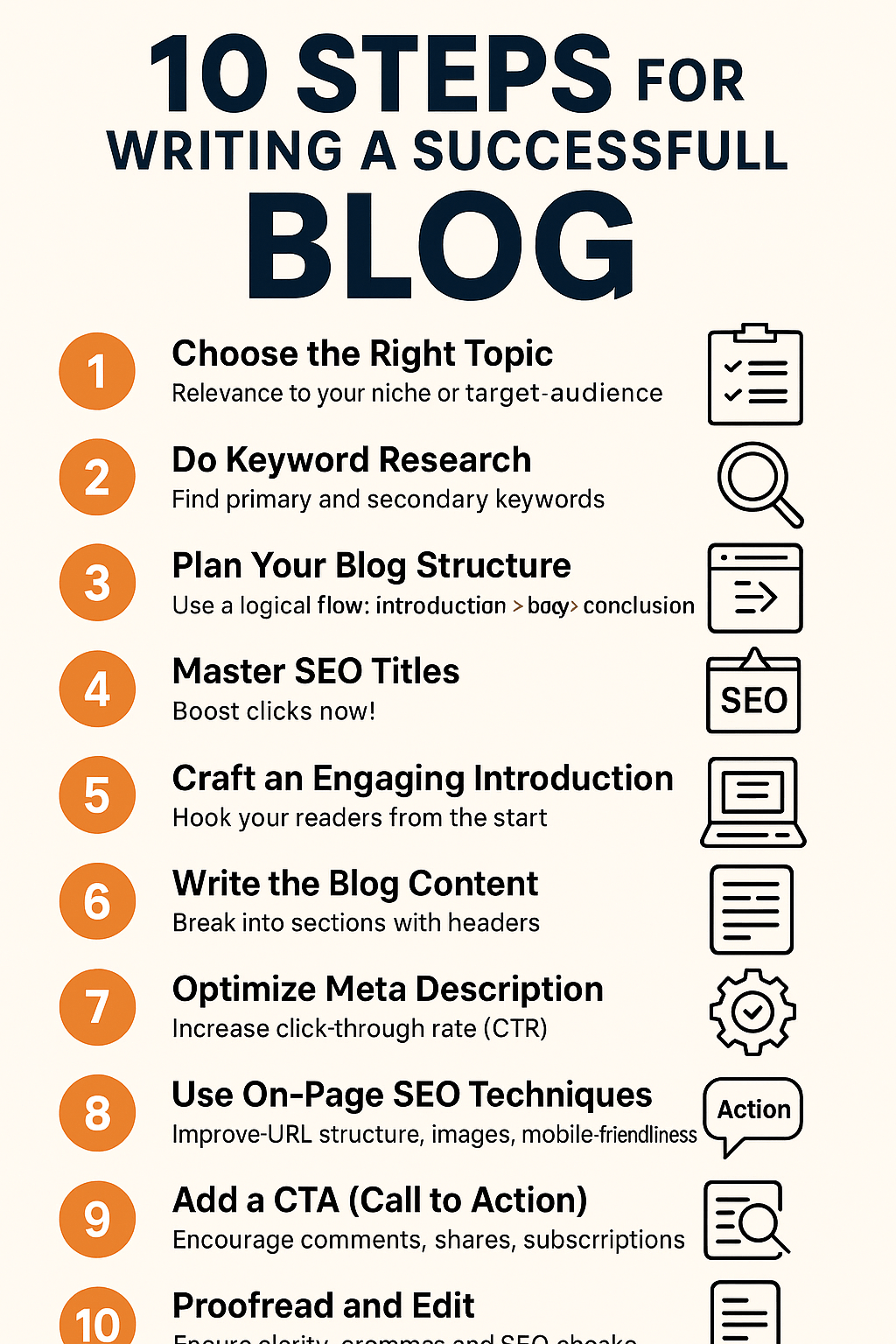If you are looking for how to write a blog? then, you are at a right place….
How to Write a Blog in 2025
In 2025’s competitive digital space, writing a blog is about blending creativity with data-driven strategy. Successful blogging now requires understanding your audience’s intent, optimizing for evolving SEO algorithms, and delivering value through engaging, multimedia-rich content.
Whether you’re educating, entertaining, or persuading, each post should follow a clear structure, use relevant keywords, and provide actionable takeaways. From AI-assisted research to interactive visuals, today’s blogs must be both human-focused and algorithm-friendly to attract, retain, and convert readers effectively.
The Importance of Blogging in Digital Marketing
Blogging is not just about sharing your thoughts, it’s a strategic pillar of digital marketing. A well-written blog can:
- Educate and engage your target audience
- Build trust and credibility in your niche
- Drive long-term organic traffic
- Nurture leads through the sales funnel
When integrated with email marketing, social media, and SEO, blogging becomes a cost-effective and long-term method to attract and retain customers.
How Blogs Help in SEO
Search Engine Optimization (SEO) is all about visibility, and blogs are fuel for your SEO engine. Here’s how:
- Fresh content: Google loves regularly updated websites. Blogs keep your site fresh.
- Keyword targeting: Each blog allows you to focus on specific keywords and search queries your audience is using.
- Internal linking: Blogs let you link to key pages (like service or product pages), improving crawlability and page authority.
- Backlink potential: Informative blogs are more likely to get cited and shared, earning backlinks from other sites.
- User engagement: Quality blogs increase time-on-site and reduce bounce rate, both important SEO signals.
1. Choose the Right Topic
How to Write a Blog that ranks and resonates starts with one of the most important steps: choosing the right topic. If you write about something no one is searching for, or something irrelevant to your audience, your blog won’t bring results, no matter how well it’s written.
Relevance to Your Niche or Target Audience
Your blog topic should align with:
- What your audience cares about
- What problems they’re trying to solve
- What services or products you offer
For example, if you’re running a tractor website like KhetiGaadi, blogging about “Best Tractors for Sugarcane Farming in Maharashtra” is more relevant than general topics like “Top 10 Crops in India”.
Ask yourself:
- What questions do my customers frequently ask?
- What topics can I write about that support my product/services?
Use of Tools Like Google Trends, Ubersuggest, or Ahrefs
You don’t need to guess the right topic, use data. These free and paid tools help you find topics people are actively searching for:
- Google Trends – Shows trending topics and their seasonality.
- Ubersuggest – Helps find keyword ideas, search volume, and SEO difficulty.
- Ahrefs/SEMrush – Advanced tools for keyword gaps, competitor blog tracking, and content ideas.
Tip: Look at what your top competitors are blogging about and find gaps or opportunities.
Consider Search Intent
Search intent means understanding why someone is searching for a keyword.
There are four types:
- Informational – “How to grow organic tomatoes”
- Navigational – “KhetiGaadi blog”
- Transactional – “Buy mini tractor online”
- Commercial – “Best tractors under 5 lakhs”
If someone searches “best fertilizer for rice farming,” they are likely in the research phase. Your blog should educate and gently guide them toward your solution, not hard-sell.
Matching content with the right intent ensures higher engagement and better rankings.
2. Do Keyword Research
Keyword research is the backbone of any successful blog post. Without targeting the right keywords, even the best content might not get discovered by your target audience. Here’s how to approach it:
✅ Find Primary and Secondary Keywords
- Primary Keyword: This is the main keyword you want your blog post to rank for. It should directly relate to your topic and have decent search volume and low to medium competition.
Example: If you’re writing about “organic farming,” your primary keyword could be “organic farming techniques.” - Secondary Keywords: These are related terms that support your primary keyword. They help Google understand the context of your content and allow you to rank for multiple related queries.
Example: For “organic farming techniques,” secondary keywords could include “natural fertilizers,” “chemical-free farming,” and “benefits of organic farming.”
Incorporating both types helps improve your blog’s semantic relevance and search visibility.
✅ Long-tail Keywords vs Short-tail Keywords
- Short-tail Keywords (also called head terms) are broad and generic, such as “farming” or “SEO.”
- High search volume
- High competition
- Lower conversion rates
- Long-tail Keywords are more specific phrases, such as “best organic farming methods in India” or “how to do on-page SEO for a blog.”
- Lower search volume
- Lower competition
- Higher conversion rates
Pro Tip: When learning how to write a blog, target long-tail keywords to attract more qualified traffic and rank faster, especially if your site is new.
✅ Tools to Use
To find the best-performing keywords, you can use the following tools:
- Google Keyword Planner: Free tool from Google Ads that shows keyword ideas, search volume, and competition level. Great for basic research.
👉 https://ads.google.com/home/tools/keyword-planner/ - SEMrush: A premium tool that provides deep keyword analysis, competitor data, and keyword difficulty scores.
👉 Useful for competitive SEO strategies and PPC campaigns. - Ahrefs: Another powerful SEO tool known for its extensive keyword database and keyword explorer.
👉 Ideal for discovering ranking potential, search intent, and related keywords.
Bonus Tip: Don’t just look at search volume, also consider:
- Search Intent: What is the user trying to achieve with their search?
- Keyword Difficulty: Can your domain realistically rank for this keyword?
- Trend: Is the keyword seasonal or growing in interest?
3. Plan Your Blog Structure
Before you start learning how to write a blog, it’s important to plan your blog’s structure. A well-organized blog post helps both readers and search engines understand your content better. Here’s how to structure your blog effectively:
Use a Logical Flow: Introduction > Body > Conclusion
- Introduction: Start with a hook that captures the reader’s attention. Briefly explain what the blog is about and what value it will provide.
- Body: Break down the main content into clear sections. Cover your key points, provide examples, and support your content with facts or visuals.
- Conclusion: Summarize the key takeaways and include a call-to-action (CTA) like subscribing to your newsletter, sharing the post, or contacting you.
Define H1, H2, H3 Usage
- H1 (Heading 1): This is your blog post title. Each page should have only one H1.
- H2 (Heading 2): Use these for main sections or topics within the blog. For example, “Benefits of Blogging” or “SEO Best Practices.”
- H3 (Heading 3): Use these under H2 sections to further divide the content into subtopics for better clarity.
Proper heading structure helps search engines index your content accurately and improves readability.
Use Bullet Points, Numbered Lists, and Short Paragraphs
- Break complex information into bullet points or numbered lists to make it easier to scan.
- Use short paragraphs (2–4 lines) to maintain readability and reduce bounce rate.
- Format important points in bold or italics to draw attention and improve user experience.
4. Master SEO Titles: Boost Clicks Now!
Want more clicks? When figuring out how to write a blog, an SEO-friendly blog title is your secret weapon! It’s the first thing people see, so make it count. Here’s how to craft a title that gets noticed:
Target Your Keywords
Always include your primary target keyword naturally in your title. This tells search engines what your content is about and helps you rank higher. For example, if your keyword is “homemade dog treats,” don’t just say “Treats for Dogs.”
Keep it Concise (Under 60 Characters)
Google typically displays about 50-60 characters of your title in search results. Anything longer gets cut off, so be precise! Aim for clarity and impact within that limited space.
Spark Emotion or Curiosity
Beyond keywords and length, a great title needs a hook. Use emotional or curiosity triggers to make people want to click. Words like “secret,” “unleash,” “transform,” or “shocking” can draw them in.
Examples:
- Original: “how to write a blog”
- Better: “SEO Title Secrets: Rank Higher, Get More Clicks!” (50 characters) – Uses keyword, short, adds curiosity
- Original: “Tips for Saving Money”
- Better: “Unlock Savings: Shocking Money Tips Revealed!” (45 characters) – Uses keyword, short, adds curiosity/emotion
5. Crafting an Engaging Introduction
Ever wonder how some blog posts instantly grab your attention, while others leave you scrolling past? When learning how to write a blog, it all comes down to a powerful introduction. The first few lines are your make-or-break moment in how to write a blog to hook your reader and keep them from bouncing away.
Hook Them Instantly
Your opening 2-3 lines are critical. They need to be captivating enough to make readers want to continue. Think about posing a question, sharing a surprising fact, or presenting a relatable problem. The goal is to pique their curiosity immediately.
Introduce Your Main Keyword Early
Don’t wait to tell search engines and your readers what your content is about. Weave your main keyword naturally into the first paragraph, ideally within the first 60-100 words. This helps with SEO and sets clear expectations for your audience.
Outline What’s Ahead
Before diving into the details, give your readers a clear roadmap. Briefly explain what your blog post will cover. This helps them understand the value they’ll gain and whether your content addresses their needs, encouraging them to read the entire piece.
Example Introduction:
Are you tired of your blog posts getting lost in the digital noise? What if unlocking more traffic was as simple as perfecting your opening lines? In this guide on how to write a blog, we’ll dive deep into crafting an SEO-friendly blog post introduction that hooks readers, signals your topic to search engines, and keeps eyes glued to your content. Whether you’re new to how to write a blog or looking to refine your skills, mastering the opening is crucial. With the right start, how to write a blog becomes a skill that consistently drives traffic and engagement.
6. Write the Blog Content
- Break into sections with headers (H2, H3)
- Maintain keyword density (1-2% max)
- Add LSI keywords (semantic relevance)
- Include images/videos (with alt text)
- Use internal and external links
7. Optimize Meta Description
Optimizing your meta description means crafting a brief, compelling summary of your web page for search engine results. Its main goal is to encourage clicks (CTR) from users.
Here are the two crucial points:
- Length: Keep it between 150-160 characters. This ensures your full message is visible and not cut off by search engines on most devices.
- Content:
- Include your main keyword: Place your primary keyword near the beginning to show relevance to the user’s search query. Search engines often bold matching keywords.
- State your value proposition: Clearly tell users why they should click on your link. What unique benefit or solution does your page offer? Use enticing, benefit-driven language and consider a soft call-to-action (e.g., “Learn more”).
Example:
- Page Topic: Organic Dog Food Benefits
- Optimized Meta Description: Discover the amazing health benefits of organic dog food. Find the best natural options to boost your pet’s vitality and well-being. Shop now!
8. Use On-Page SEO Techniques
On-Page SEO refers to all the optimization efforts you make directly on your website to improve its search engine ranking and user experience. It’s about making your content as clear, relevant, and accessible as possible.
URL Structure (Short and Keyword-Rich)
Your URL (Uniform Resource Locator) is the web address of your page, and it’s one of the first things search engines see.
- Short: Aim for conciseness. Shorter URLs are easier for users to remember, type, and share. They also look cleaner in search results. Avoid long strings of numbers or irrelevant characters.
- Keyword-Rich: Include your main target keyword(s) in the URL. When following how to write a blog guidelines, this immediately signals to search engines and users what the page is about. Applying how to write a blog strategies in your URL structure reinforces the page’s relevance to specific search queries.
Example:
- Bad URL: www.yourwebsite.com/blog/article-id-23456789
- Good URL: www.yourwebsite.com/blog/best-gardening-tips (If the topic is “best gardening tips”)
Image Optimization (File Size, Alt Tags)
Images enhance your content, but if not optimized, they can hinder your SEO.
- File Size: Large image files slow down your page load speed, which is a significant ranking factor and a major source of user frustration.
- Technique: Compress images using tools (online compressors, image editors) before uploading. Choose appropriate formats (e.g., JPEG for photos, PNG for graphics with transparency).
- Alt Tags (Alternative Text): These are text descriptions of images that search engines read (as they can’t “see” images) and screen readers use for visually impaired users.
- Technique: Provide descriptive, keyword-rich alt text for every image. When applying how to write a blog best practices, describe what the image depicts accurately, and if relevant, include your target keyword naturally.
- Example: For an image of a cat eating dry food, alt text could be alt=”Siamese cat enjoying healthy dry cat food”
Mobile-Friendliness, Readability, and Load Speed
These three aspects are crucial for user experience and are heavily weighted by search engines, especially Google.
- Mobile-Friendliness:
- Explanation: With most internet traffic now coming from mobile devices, Google heavily prioritizes websites that are responsive and provide a seamless experience on smartphones and tablets.
- Technique: Ensure your website uses a responsive design that automatically adjusts layouts, text, and images to fit any screen size. When learning how to write a blog, remember to test your site regularly on various devices.
- Readability:
- Explanation: This refers to how easy your content is for humans to read and understand. Search engines value content that is clear, well-structured, and engaging, as it leads to longer user engagement.
- Technique:
- Use short paragraphs and sentences.
- Employ headings (H2, H3, H4) to break up text.
- Use bullet points and numbered lists for easy scanning.
- Choose clear, legible fonts and appropriate font sizes.
- Maintain good contrast between text and background colors.
- Load Speed:
- Explanation: How quickly your page loads from the moment a user clicks on it is a critical SEO factor. Slow pages frustrate users, leading to high bounce rates, and are penalized by search engines.
- Technique:
- Optimize images (as mentioned above).
- Minimize CSS and JavaScript files.
- Use a reliable web hosting provider.
- Leverage browser caching.
- Consider using a Content Delivery Network (CDN).
- Regularly check your page speed using tools like Google PageSpeed Insights.
By actively implementing these on-page SEO techniques, you not only learn how to write a blog that ranks higher but also create a website that delivers a superior experience for every visitor. Mastering how to write a blog with strong SEO ensures long-term visibility and audience engagement. Watch our video
9. Add a CTA (Call to Action)
- Encourage comments, shares, subscriptions, or product actions
10. Proofread and Edit
This final step ensures your content is polished and effective.
- Use Grammarly or Hemingway Editor:
- Grammarly: Checks for correct grammar, spelling, punctuation, and overall writing quality.
- Hemingway Editor: Focuses on readability, simplicity, and conciseness, highlighting complex sentences.
- Purpose: Catch errors and improve writing style.
- Ensure Clarity, Grammar, and SEO Checks:
- Clarity: Make sure your message is easy to understand and flows logically.
- Grammar: Eliminate all spelling, punctuation, and grammatical errors for professionalism.
- SEO Checks: Confirm all on-page SEO elements are correct (keywords, headings, links, alt text, meta description) to boost search engine visibility.
Overall Goal: Deliver high-quality, error-free content that’s optimized for both readers and search engines. Learn how to write a blog.

Conclusion
Creating a high-ranking, engaging blog isn’t about luck—it’s about strategy. When you understand how to write a blog, from selecting the right topic and doing smart keyword research to structuring your content, optimizing for SEO, and crafting compelling titles and introductions, every step matters.
Knowing how to write a blog effectively means combining valuable, well-organized content with strong on-page SEO and a clear call-to-action, so you not only attract more visitors but also convert them into loyal readers or customers. Consistency, data-driven decisions, and attention to detail are the keys to turning your blog into a powerful growth engine. read OFF-Page SEO Guide


